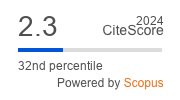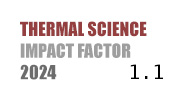THERMAL SCIENCE
International Scientific Journal
STUDY ON THE EFFECT OF ASH LAYER ON FLOW AND HEAT TRANSFER IN DIESEL PARTICULATE FILTER BASED ON 3-D THERMAL LATTICE BOLTZMANN METHOD
ABSTRACT
After the Diesel engine works for a long time, dense ash layer will be formed on the diesel particulate filter surface, which will increase the back pressure on the diesel particulate filter surface and seriously affect the normal operation of the diesel particulate filter. The diesel particulate filter micro-structure is generated by 3-D reconstruction technology. Moreover, the particle layer and ash layer are reconstructed by quartet structure generation set. The exhaust gas with a velocity of 0.05-0.25 m/s is introduced into the diesel particulate filter model. Under the condition of 873 K temperature field, the 3-D lattice Boltzmann method is used to explore the influence of the particle layer and ash layer accumulated in its micro-structure on its flow and heat transfer. The results show that with the accumulation of ash, the flow velocity in the diesel particulate filter increases with the decrease of porosity. The existence of ash layer increases the pressure difference between the inlet and outlet of the structure, and the pressure difference between the inlet and outlet of the structure increases with the increase of the air inlet speed. Under the same flow conditions, the heat transfer process of structures containing ash stratification is faster, and the highest temperature point moves forward accordingly. This has certain guiding significance for exploring the thermal load of ash containing diesel particulate filter structure.
KEYWORDS
PAPER SUBMITTED: 2022-11-09
PAPER REVISED: 2023-01-04
PAPER ACCEPTED: 2023-01-06
PUBLISHED ONLINE: 2023-03-11
THERMAL SCIENCE YEAR
2023, VOLUME
27, ISSUE
Issue 5, PAGES [4091 - 4101]
- Lloyd, A. C., et al., Diesel Engines: Environmental Impact and Control, Journal of the Air and Waste Management Association, 51 (2001), 6, pp. 809-847
- Rhys-Tyler, G. A., et al., The Significance of Vehicle Emissions Standards for Levels of Exhaust Pollution from Light Vehicles in An Urban Area, Atmospheric Environment, 45 (2011), 19, pp. 3286-3293
- Sappok, A., et al., Ash Effects on Diesel Particulate Filter Pressure Drop Sensitivity to Soot and Implications for Regeneration Frequency and DPF Control, SAE International Journal of Fuels and Lubricants, 3 (2010), 1, pp. 380-396
- Wang, H., et al., Ash Deposited in Diesel Particular Filter: A Review, Energy Sources - Part A: Recovery, Utilization, and Environmental Effects, 41 (2019), 18, pp. 2184-2193
- Song, C., et al., Carbonyl Compound Emissions from a Heavy-Duty Diesel Engine Fueled with Diesel Fuel and Ethanol-Diesel Blend, Chemosphere, 79 (2010), 11, pp. 1033-1039
- Bai, S., et al., Influence of Active Control Strategies on Exhaust Thermal Management for Diesel Particular Filter Active Regeneration, Applied Thermal Engineering, 119 (2017), June, pp. 297-303
- Giechaskiel, B., et al., Engine Exhaust Solid sub-23 nm Particulates: II, Feasibility Study for Particulate Number Measurement Systems, SAE International Journal of Fuels and Lubricants, 7 (2014), 3, pp. 935-949
- Wang, H., et al., Pore Morphology and Fractal Dimension of Ash Deposited in Catalyst Diesel Particulate Filter, Environmental Science and Pollution Research, 27 (2020), 10, pp. 11026-11037
- Gao, J. B., et al., A Review of Fundamental Factors Affecting Diesel PM Oxidation Behaviors, Science China Technological Sciences, 61 (2018), 3, pp. 330-345
- Fu, J., et al., Four Kinds of the Two-Equation Turbulence Model's Research on Flow Field Simulation Performance of DPF's Porous Media and Swirl-Type Regeneration Burner, Applied Thermal Engineering, 93 (2016), Jan., pp. 397-404
- Mohamad, A. A., Lattice Boltzmann Method, Springer, London, UK, 2011
- Yamamoto, K., et al., Simulation on Soot Deposition and Combustion in Diesel Particulate Filter, Proceedings of the Combustion Institute, 32 (2009), 2, pp. 1965-1972
- Yamamoto, K., et al., Simulation on Catalytic Reaction in Diesel Particulate Filter, Catalysis Today, 153 (2010), 3-4, pp. 118-124
- Yamamoto, K., et al., Simulation of Heat Conduction and Soot Combustion in Diesel Particulate Filter, Progress in Computational Fluid Dynamics, an International Journal, 12 (2012), 4, pp. 286-292
- Yamamoto, K., et al., Simulation of Continuously Regenerating Trap with Catalyzed DPF, Catalysis Today, 242 (2015), Part B, pp. 357-362
- Li, Z., et al., Simulation of Soot Particulate Deposition Inside Porous Walls Based on Lattice Boltzmann Method for Diesel Particulate Filter, Journal of Environmental Chemical Engineering, 9 (2021), 4, 105396
- Hu, X., et al., Analysis of Boundary Conditions for Lattice Boltzmann Model, Journal of Hydrodynamics, (2003), 2, pp. 127-134
- Meng, Z., et al., Effect of Particulate Characteristics on DPF Regeneration Performance, Journal of Combustion Science and Technology, 24 (2018), 2, pp. 186-191
- Yang, J., et al., Single Wall Diesel Particulate Filter (DPF) Filtration Efficiency Studies Using Laboratory Generated Particulates, Chemical Engineering Science, 64 (2009), 8, pp. 1625-1634
- Ou, J., et al., Experimental Investigation on the Variation Characteristics of Soot Layer Thickness and Pressure Drop during DPF/CDPF Active Regeneration, Chemical Engineering Science, 241 (2021), 116682
- Meng, Z., et al., Experimental Study on the Influence of DPF Micro-Pore Structure and Particle Property on its Filtration Process, Journal of Combustion, 2016 (2016), ID9612856
- Cho, H., et al., Permeability of Micro-Scale Fibrous Porous Media Using the Lattice Boltzmann method, International Journal of Heat and Fluid-Flow, 44 (2013), Dec., pp. 435-443
- Kitao, T., et al., Validation of LBM Simulation of Saturated Seepage Flow through 3-D-Printed Homogeneous Porous Medium for Fluid-Particle Coupled Analysis, Acta Geotechnica, 16 (2021), 8, pp. 2643-2656

